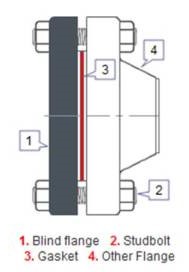Flange Types
Flange Types
1) Weld Neck Flange:
- The weld neck flange is referred to as the high hub flange.
- They are generally used for sizes 2" and above.
- It is designed to reduce the high stress concentration at the base of the flange by transferring stress to the adjoining pipe.
- Although expensive, the weld neck flange is the best designed butt weld flange.
- This flange is manufactured with a long tapered hub.
- The tapered hub is created by the gradual increase in metal thickness from the weld joint to the flange facing.
- The symmetrical taper transition is extremely beneficial under conditions of repeated bending caused by the line expansion, contraction, or other external forces.
- This type of flanges are used in severe service applications involving high pressures, high temperatures or sub-zero conditions.
- This flanges are bored to match the ID of the adjoining pipe. In other words, thinner the wall of pipe, larger the bore through the flange. thicker the wall of pipe, smaller the bore.
- Because of these matching IDs, there is no restriction to the flow. Turbulence & Erosion are eliminated.
2) Screwed Flanges:
- In Screwed flanges, The bore is threaded.
- Its principle value is that it can be assembled without welding. This feature makes the threaded flange well suited to extreme pressure services that operate at normal atmospheric temperatures and in highly explosive areas where welding may create hazard.
- This flange is not suitable for conditions involving temperatures or bending stress of any significance, particularly where cyclic conditions exist, which may cause leakage through the threads.
- It is similar to Slip-On flange.
- A seal weld is sometimes applied around the threaded joint to reduce possibility of leakage, Though this technique is not considered satisfactory.
- It is mainly used on small bore piping of non critical services.
3) Socket Weld Flange:
- They are used on sizes 11/2" and smaller.
- The pipe is inserted into the socket on the flanges and is fillet welded. An internal weld is often employed for added strength.
- By grinding the interior weld smooth, turbulence and flow restriction are kept to a minimum.
Slip-On Flange:
- The Slip-On flange has a low hub that allows the pipe to be inserted into the flange prior to welding.
- Shorter in length than the weld neck flange, This flange is used in areas where short tie-ins are necessary or space limitations necessitate its use.
- Its lifespan is about one-third of weld neck flange.
5) Lap-Joint Flange:
- This consists of a stub end which is welded on to the pipe and a loose flange.
- This flange is used primarily on Carbon & Low alloy steel piping systems.
- These are used when pipe material is costly. For example If the piping material is stainless steel, the stub end will be stainless steel and loose flange will be carbon steel which is cheaper.
- This is used where frequent dismantling for inspection or rountine maintanence. It is also used in the erection of large diameter or hard to adjust piping configurations because of its quick bolt hole alignment.
6) Reducing Flange:
- Reducer flange is used to make reduction in the diameter of the pipe.
- This type of flange is most frequently used in installations with limited space.
- During operation the flow must travel from the smaller size to the larger. if the flow is reversed severe turbulence could develop.
- Reducer flanges are manufactured as weld neck, slip-on, or threaded flange types.
7) Blind Flange:
- Blind flange is used to terminate the end of a piping system.
- Its function is similar to that of plug or cap.
- It does not have hub or a bored center.
- Blind flanges have the face thickness of a flange, a matching face type, and similar bolting pattern.
- It can be used to seal a nozzle opening on a pressure vessel and can reopened later for inspection.
8) Orifice Flange:
- Orifice flange function is to measure the rate of flow of commodity through the piping system.
- Orifice flanges are easy to recognize because they have holes drilled through the face of the flange perpendicular to the pipe.
- They also have additional set of bolts called jack screws, which is used to separate the flange so inspection and/or replacement of the orifice plate can be performed.
- The orifice flange is a single component of the orifice flange union assembly.
- The Orifice flange union is composed of two orifice flanges, an orifice plate, bolts, nuts, jack screws and two gasket.
- The orifice flange union is used to measure or meter the amount of pressure drop through the orifice plate.
- This types of flanges can be either weld neck, threaded (both manufactured in 300# and larger pound ratings) & slip-on (only available in 300# RF flange).















Comments
Post a Comment